GE Icemaker Repair
This page will describe how a GE icemaker works and what to do to repair them.
These icemakers are simple to repair but can be difficult to understand. This
page will clear that up. This page is about GE mechanical icemakers with the
metal wire on the side and gears on the front behind the front cover as shown.
Also this page is intended for more complicated/ less common problems with GE
icemakers. This is a link to a page that will help with more common problems and
will help with problems with the GE electronic icemaker. GE Icemaker
Repair Guide This link also covers the GE electronic icemaker.
This
page covers the GE mechanical icemaker with the wire arm and gears on front as
shown below.
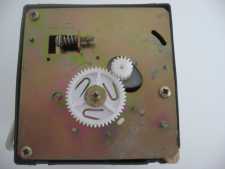
When repairing icemakers it is important to know how much ice the icemaker
should produce. Icemakers typically dump once every 1-2 hours An icemaker that
dumps once an hour has strong icemaker production and an icemaker that dump once
every 2 hours is weak but still acceptable. So in 24 hours, the icemaker should
make approximately 80-175 cubes. Typically it will take 24-48 hours for an
icemaker bin to fill and longer if the refrigerator is just starting up. If your
icemaker is producing ice but slowly, the first thing to check before going
through troubleshooting steps provided on this page is the temperature in the
freezer. The temperature should be around 0-10 degrees. Note that if you are
taking air temperature, the door of the freezer should be closed for at least 30
minutes before reading temperature. If you don’t have a thermometer, a good
indication that the temperature in the freezer is acceptable is ice cream. If
the ice cream is hard the temperature is acceptable and if the ice cream is soft
check out this page Refrigerator
Not Cooling.
There are three switches in this icemaker. One is a called a motor hold switch and is located under the white cam. Another is called the ice level switch and is located near the spring attached to the wire. The other is the water valve switch and it is attached to the adjustment screw.
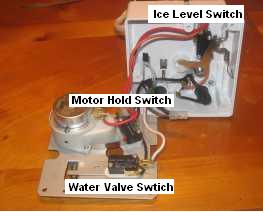
When the icemaker gets cold enough the thermostat trips and bypasses the motor switch that will start the motor provided the ice-level switch is tripped (wire has got to be completely down). Once the motor starts, it will push all the ice in the ice molds out. The heater comes on to help this process. At the end of the cycle, the water valve switch will trip (how long it stays tripped depends on the adjustment screw) activating the water valve. Then the cam lets off the motor switch and cuts the motor off. If there is ice in the icemaker when this process begins, the water valve will not activate on the first round because the thermostat will be still closed when the icemaker reaches the end of the cycle. Water doesn’t enter the icemaker if the thermostat is closed but because the thermostat is still closed the motor switch will automatically be bypassed and the icemaker will continue another cycle. This time there is no ice in the icemaker so the thermostat opens due to the fact that the heater is on and allows the water to enter. This time the icemaker will stop and not come back on until the thermostat closes again indicating the water has frozen.
GE Icemaker Diagrams
I put together some wiring diagrams to help you better
understand how GE icemakers work. The arrows indicate current flow path and the
wires are color-coded.
In this diagram there is no current flow. The
thermostat is open, the motor hold switch is in hold position and the ice level
switch indicating that ice bin isn't full.

In this next diagram there is no current flow even though the thermostat is closed. This is because the ice level switch indicates that the ice bin is full.
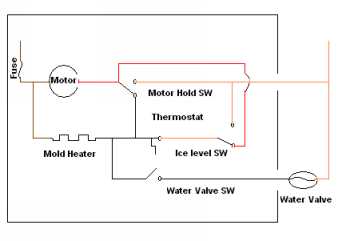
In this diagram the thermostat is closed and the ice bin is empty so the motor will start along with the mold heater.
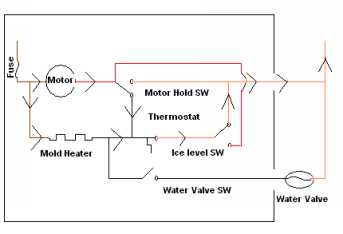
Once the motor turns a little the motor hold goes to the run position as shown below.
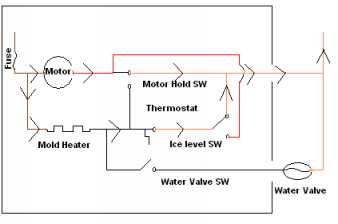
Then the water valve switch closes to run water but the thermostat is still closed so electricity takes the path of least resistance and doesn’t activate that water valve. But since the thermostat is still down the icemaker will continue the cycle. This time around there is no ice in the icemaker so the thermostat will close because of the heat from the mold heater.
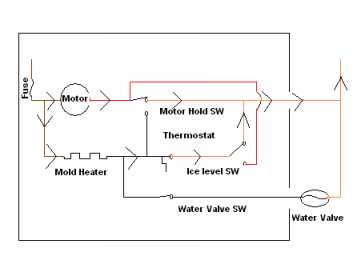
Each time the icemaker cycles, a cam lifts up the wire on the side of the icemaker and lets it down so that if the ice bin is full the wire will hit the ice and the icemaker will not dump until the ice is gone. This is done just before the water valve is activated. This next diagram shows what will happen if the ice level switch indicates the ice bin is full but the thermostat is still closed. The water valve still doesn’t activate because electricity still takes the path of least resistance, only this time the icemaker will stop when it gets to the end of the cycle because the ice level switch will stop the icemaker. Then once the ice level switch indicates the bin is no longer full, the icemaker will cycle and fill with water.
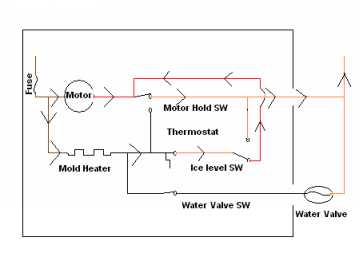
This next diagram shows the water valve being activated with the thermostat open. Once done, the icemaker will stop when the motor hold switch is in the hold position at the end of the cycle.
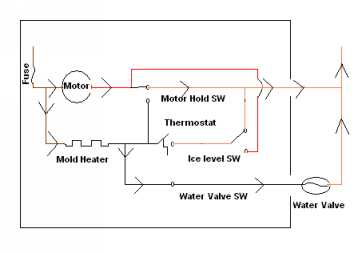
Return From GE Icemaker Repair